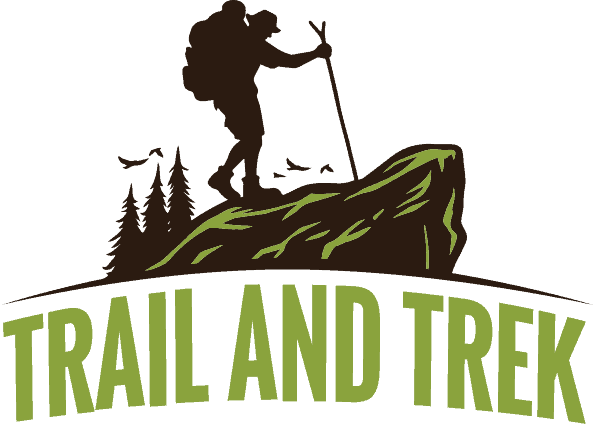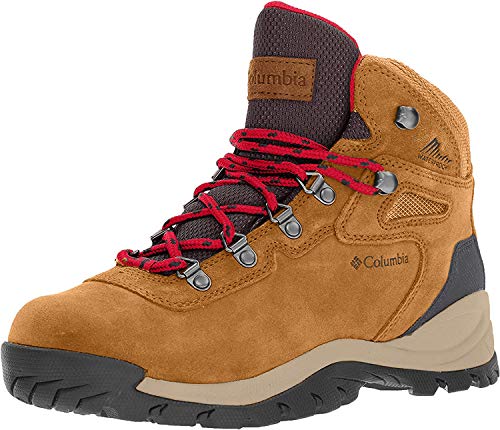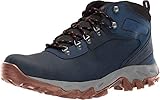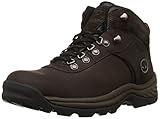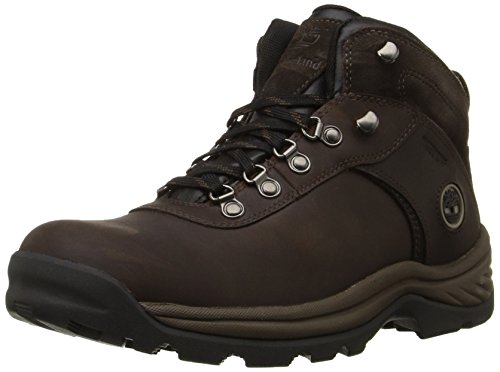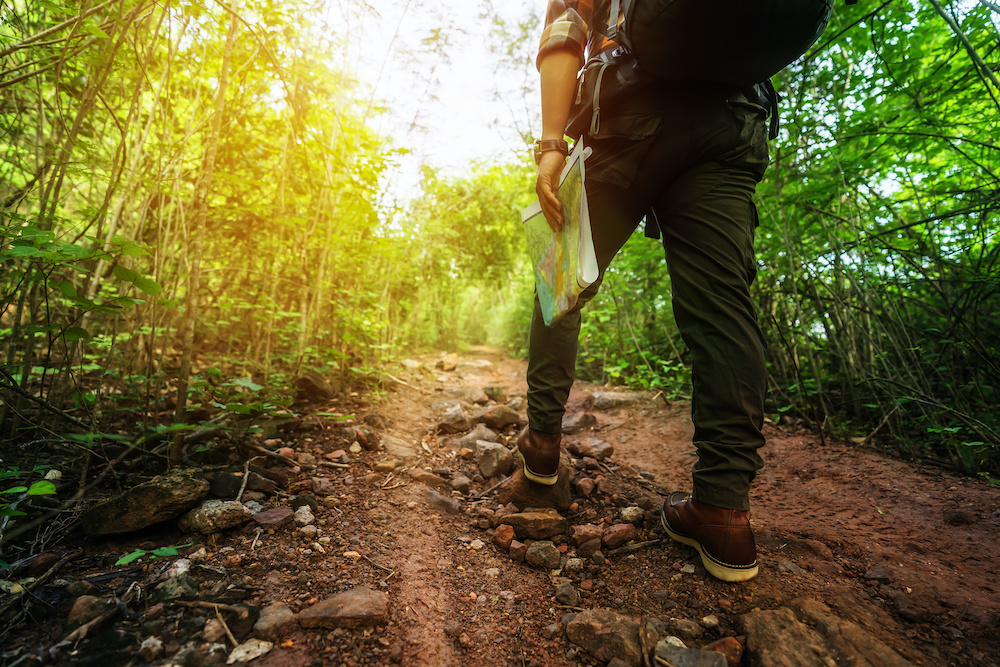
Hiking boots are important whether you are someone who hikes once in a while or does it often. Going on one with the wrong shoes could be catastrophic. The probability of you twisting your ankle, slipping, falling, or developing blisters rises significantly.
The solution to those problems is hiking boots. Thankfully, you don’t need to break the bank to own a good one.
Our team of experts has put together a detailed guide and reviews of the best hiking boots under 100 for both men and women. You will find all the essential information you need below.
Women's Hiking Boots
Comparison Chart
Best Hiking Boots Under 100 for Women
1. Columbia Women’s Newton Ridge Plus Hiking Boots
The Columbia Women’s Newton Ridge Plus Hiking Boots is an excellent and sturdy pair of hiking boots for any woman who does more than the weekend hike.
Product Highlights
This pair of hiking boots is a full-grain leather shoe with a suede bootie construction and a highly durable mesh for breathability. It is available in multiple attractive colors, such as tan, light blue, red, brown, and more. It comes with a rubber sole and its shaft measures about five inches from its arch.
The shoe comes with interesting features. For starters, it is quite lightweight and has a durable midsole for long-lasting comfort. It has superior cushioning, too.
This pair of boots comes with Omni-Grip advanced traction technology, which provides a tight grip for every environment. The boots come in a wide range of sizes, from five to size 12.
What We Like
These boots are built very well. They are ideal for women who hike regularly and need ample features to keep their feet secure and protected. We also like that there are multiple color options available.
What We Did Not Like
The shoe is not ideal for women who have wide feet. In case you do, we would recommend buying half a size bigger.
Pros:
- Comes with Omni-Grip technology
- Full-grain leather
- Superior cushioning and durable
Con:
- Not ideal for wide feet
2. Gracosy Women’s Hiking Shoes
If you are on a very tight budget and need a shoe for light hiking trips, then the Gracosy Women’s Hiking Shoe is your best bet.
Product Highlights
These hiking shoes are made using premium suede upper and are ideal for hikes in cold weather. It is durable and comes with a wear-resisting outsole. The shoe is soft and warm and is lined with faux fur. It comes in multiple color options, too.
The shoes come with a wavy-strip. This protects the sole with anti-slip features. Its soft rubber soles also provide the feet with ample support and stability, thus reducing the pressure on your feet.
In terms of looks, it has a special hook-loop style on its upper seam, which makes it more stylish.
What We Like
We like that the shoe is lined with faux fur on the inside. This makes the shoe not only comfortable but also keeps your feet warm during those cold weathers.
What We Did Not Like
These boots are mostly meant for day hiking trips only on an even trail. They can also be a bit narrow for some at the toes.
Pros:
- Lined with faux fur
- Offers ample support
- Attractive looking shoe
Con:
- Not for serious hikers
3. XPETI Women’s Hiking Outdoor Boots
The XPETI Women’s Hiking Outdoor Boots is ideal for women who want high-top hiking boots. We talk about some of its top features below.
Product Highlights
This hiking shoe is made using a synthetic fabric. It comes with a waterproof mesh upper. While it is great for all kinds of weather, they are the best for those cold snow-filled hikes because they will keep your feet warm and dry throughout.
They are also integrated with an EVA midsole, which makes it sturdy and lightweight. The shoes have a special technology that protects your feet. Its molded rubber toe cap and molded TPU at the heel offer brilliant protection.
The shaft of these shoes measures around eight inches from the arch. Lastly, you can choose from an array of colors, like black, white, camouflage, charcoal gray, and several more.
What We Like
We like that these shoes have a high-top, making it ideal for those cold winters. They also offer ample support and stability for your entire feet.
What We Did Not Like
The biggest downside to these boots is that they are quite stiff and can take a very long time to fully break-in.
Pros:
- High-top design
- Offers ample stability
- Available in different colors
Con:
- Needs a lot of time to break-in
4. Ariat Women’s Hiking Boots
The Ariat Women’s Hiking Boots is a simple pair of hiking boots with some interesting features that will make your hike quite comfortable.
Product Highlights
These Ariat boots are built to keep up with the athletic demands of the outdoors. They offer phenomenal performance, comfort, and durability, which are especially important for serious hikers.
These shoes come with a four-layer footbed for cushioning. It is lightweight and has a stabilizing shank for support. It also comes with a Duratread outsole, which provides the shoe with maximum wear-resistance.
The shoe is made of 100% leather, is completely waterproof, and has an oiled full-grain leather upper. It has been designed with a synthetic sole for stability.
You will find these boots available in a wide range of sizes, from 5.5 to 11. There are even special sizes for hikers with wide feet. The shoe is available in copper and distressed brown.
What We Like
This is a shoe for the woman who is a serious hiker. It is made of 100% leather and is completely waterproof. It has a moisture-wicking lining along with a self-cleaning Duratread outsole, as well.
What We Did Not Like
The sizing can be a bit confusing for some people, and there are others who have complained that it can be a bit too wide at the heel.
Pros:
- Ideal for serious hikers
- Waterproof
- Features ample cushioning
Con:
- Sizing issues
5. XPETI Women’s Dimo Mid Hiking Boots
The last hiking boots for women we are reviewing are the XPETI Women’s Dimo Mid Hiking Boots. This is a sturdy pair of boots with some amazing features.
Product Highlights
This hiking boot is available in a wide range of colors and is a perfect blend of fashion and functionality. The shoe comes integrated with an EVA midsole and is sturdy even when you carry heavy weights.
It features a rubber toe cap protection and a rubber outsole for optimal trail grip. The shoes provide brilliant arch and ankle support, which leaves your feet feeling secure when you hike on rugged trails. Its aggressive sole grabs rocks and gives you good traction.
The shoe is made of the same material as the previous XPETI shoe we reviewed. They are breathable and durable and will provide you with ample stability.
What We Like
We like that this shoe has a wide range of color options. It is highly durable and breathable and will provide you with a good amount of protection even on unstable ground.
What We Did Not Like
The shoe sizing does run small, so you have to buy either half or one size larger.
Pros:
- Comes with an EVA midsole
- Provides good ankle support
- Offers good traction
Con:
- Size runs small
Men's Hiking Boots
Comparison Chart
Best Hiking Boots Under 100 for Men
1. Timberland Men’s Ankle Hiking Boot
Timberland is a well-known brand all over the world. People love this brand because of its high-quality shoes, and its hiking shoes live up to the same standard.
Product Highlights
This pair of hiking boots is made using 100% leather. Its shaft measures about 4.75 inches from its arch, and it comes with premium full-grain waterproof leather uppers.
At closer inspection, you will notice that it has a seam-sealed waterproof construction and a rustproof speed lace hardware with hooks at the top for secure lacing. It comes with a fully gusseted tongue and an EVA footbed and midsole, as well.
These boots are highly comfortable, durable, and, most importantly, great looking. Its sizes range from seven to 15, with sizes for wide feet, too. It is also available in multiple colors, such as dark brown, tan, black, and so on.
What We Like
These hiking boots from Timberland are a great choice for any man who goes on hikes regularly. In addition to looking good, the shoe keeps your feet secure, too.
What We Did Not Like
These shoes are not an ideal option if you intend to use it during cold weather. Unfortunately, they will not keep your feet warm.
Pros:
- Made from leather
- Waterproof
- Attractive design
Con:
- Not for cold weathers
2. Columbia Men’s Hiking Boot
The last hiking boots on our list come from a high-quality and reputable shoe brand, Columbia. This Newton Ridge Plus II Hiking Boots is quite impressive.
Product Highlights
These boots from Columbia are crafted from full-grain leather and suede. It has a durable mesh tongue that offers excellent breathability and durability during those hot sunny days.
It comes in several colors, including black, dark brown, navy blue, and more. Its size ranges from size seven to size 17, with options for wide feet.
The shoe’s shaft measures five inches from the arch, and its platform measures about 0.5 inches. This shoe comes with Techlite Lightweight midsole for long-lasting and superior comfort. There’s also an Omni-grip rubber sole for advanced traction and for slip-free movements.
What We Like
We like that this shoe comes with features like Techlite midsole and Omni-grip traction rubber sole, which make the shoe more durable. It is also quite lightweight and offers great breathability.
What We Did Not Like
These hiking shoes are not meant to be used on trails that are too strenuous as they may end up causing blisters on your feet.
Pros:
- Available in many sizes
- Offers great support and breathability
- Offers good grip
Con:
- Not ideal for long hikes
3. Quicksilk Eyushijia Men’s Hiking Boots
Do you need hiking boots that will work well in snow? We recommend checking out the Quicksilk Eyushijia Men’s Hiking Boots.
Product Highlights
These hiking boots are much lighter than most of its competitors, and this makes it great for hiking and other outdoor activities. These are particularly great to use in cold weather, thanks to its faux leather creation.
The shoe has ample room within, too. It is made while keeping in mind a wide fit design. As such, you can be sure that the shoe will keep your feet snug without compressing your toes and forefeet.
Its collar is padded, too, which enables the shoes to have perfect cushioning around the ankles. Its sturdy rubber sole also allows easy movement on slippery snow.
What We Like
We like that these boots are more lightweight compared to most hiking boots on the market. It is also ideal for snow and keeps your feet sufficiently warm.
What We Did Not Like
We wish that the company invested a bit more time in the quality of this shoe. The shoe will give up after months of consistent use.
Pros:
- Snug fit
- Features soft and durable faux leather
- Padded collar for ankle support
Con:
- Average overall quality
4. Timberland Men’s Flume Waterproof Boots
It is no surprise that we have included yet another pair of Timberland hiking boots on our list, and this one also comes with amazing features.
Product Highlights
These hiking shoes are made using premium full-grain waterproof leather. It is waterproof and has a seam-sealed construction that will keep your feet dry.
Its fully gusseted tongue does a good job at keeping out debris, and its compression-molded EVA footbeds and midsole provide the shoes with lightweight cushioning and impressive shock-absorption.
These shoes come with a solid rubber outsole equipped with multidirectional lugs for better traction. Its shaft measures five inches from the arch. This is also available in sizes ranging from seven to 15, with wide sizes, as well. Lastly, the shoe is available in black and dark brown.
What We Like
We like that these shoes are made using premium full-grain waterproof leather. Its construction makes it waterproof and comfortable for long hikes.
What We Did Not Like
The shoes come with a very thin leather upper that tends to get scuffed up quite easily. Unfortunately, this makes the shoes look dirty.
Pros:
- Highly comfortable
- Solid rubber sole
- Available in multiple sizes
Con:
- Thin leather uppers
5. Skechers Men’s Chukka Boots
Skechers is a well-known in the shoe market. It is known for its highly comfortable and stylish range of shoes. Does its pair of Chukka boots also keep up with the rest? Let’s find out.
Product Highlights
These are durable, waterproof shoes made of suede. It comes with a synthetic and mesh fabric in a lace-up, ankle-height hiking style boots. The stitching and overlay accents are attractive, and the insole is made of memory foam.
The shoe has a lightly textured durable synthetic overlays at the heel and toe. Its mesh fabric collar and lace area detail provide ample breathability.
Its gusset tongue keeps your feet safe from harsh weather and debris. The shoe comes with a shock-absorbing midsole and a rubber toe bumper front. It has a flexible rubber high-traction lug patterned outsole, along with a 1.5-inch heel.
What We Like
The shoe provides ample support and stability. What we liked, in particular, is the fact that its size ranges from six and goes all the way to size 16. It also fits as expected.
What We Did Not Like
The shoes are not the most comfortable when you first wear them, and it will take quite a while for it to fully break-in.
Pros:
- Ideal for most weather
- Comes with a shock-absorbing midsole
- Has a memory foam insole
Con:
- Takes time to break-in
Buyer’s Guide
We are certain that you were surprised to find so many options for hiking boots for men and women on a budget. Every one of them is designed beautifully and comes with spectacular features that will truly make your hike worthwhile.
Most important of all, you will not be breaking the bank by opting for any of these shoes. With that said, if you’re still not sure which one of them to settle for, we recommend that you go through our detailed buyer’s guide.
Below, we will talk about the top aspects of a good hiking shoe.
1. Types
You would think that there would be just one kind of hiking boots, but the reality is that there are different types depending on the kind of hike you plan on taking. There is a massive range of footwear for this activity, including mountaineering boots, ultralight trail shoes, and several more.
Let us discuss the most common types of hiking boots below.
Hiking Shoes
These shoes are typically ones that have a low-cut design and have midsoles that are quite flexible. These are an excellent choice if you are going for a day hike. This is also an ideal choice for ultralight backpackers who are making long-distance journeys.
Day Hiking Boots
These shoes will typically range from either mid- to high-cut styles. Their main purpose is for day hikes or quick backpacking trips that tend to have a light load.
These types of shoes will flex quite easily and will also require some amount of break-in time. However, they lack the durability and the support of stout backpacking boots.
Backpacking Boots
These kinds of shoes are specially designed to carry heavier loads on trips that go on for multiple days deep into the backcountry. You will often find them sporting a high-cut style that will wrap above the ankle. These shoes offer brilliant support.
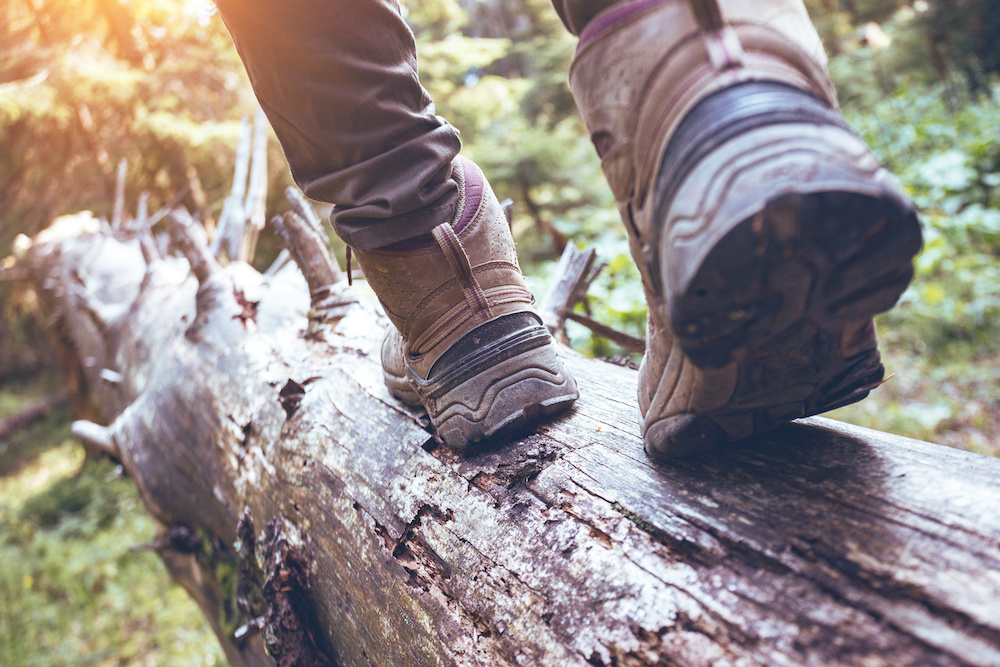
These shoes are highly durable and supportive. They tend to have a stiffer midsole compared to their lighter counterpart. They are ideal for on- or off-trail travel.
2. Components
Hiking boots have different components and understanding each of them could further help you decide which one to go for. There are several components that make up a hiking boot. Let us discuss each of them briefly below.
Hiking Boot Uppers
There are different materials here that can impact the boot's breathability, weight, durability, and water-resistance. These materials include:
Full-Grain Leather
Materials like full-grain leather will give the boots excellent abrasion-resistance, water-resistance, and overall durability. You will find this material is commonly used in backpacking boots made for heavy loads, extended trips, and rugged terrains.
However, full-grain leather is not as breathable or as lightweight as the split-grain leather/nylon combinations. This will need a good amount of break-in time before you use it for a trip.
Split-Grain Leather
Split-grain leather is typically paired along with nylon or nylon mesh. This combination helps create a lighter boot that offers better breathability.
This material splits away from the rough inner section of the cowhide from the smooth exterior. This results in a lower cost. However, there is a downside here, and that is lesser resistance to abrasion and water (there are several waterproof liners, however).
Nubuck Leather
This material is full-grain leather that is buffed to give it a similar appearance to suede. It is highly durable and also resists abrasion and water. It is also quite flexible but requires a lot of time to break in before you can use it for an extended hike.
Synthetics
Materials such as nylon, polyester, and even the so-called “synthetic leather” are all typically found in new-age boots. These are much lighter than leather, can be broken into much more quickly, dry faster, and even cost lower.
The downside, though, is that they will show signs of wear and tear much quicker due to more stitching that is on the outside of the boot.
Waterproof Membranes
Shoes and boots that are sold as “waterproof” will often feature uppers that are made with breathable/waterproof membranes, such as eVent ® or Gore-Tex ®, to keep your feet dry in wet conditions.
The downside with this, though, is that it will have reduced breathability. This is caused by a membrane that may encourage your feet to sweat during those hot summer days.
Vegan
This is pretty self-explanatory. Vegan-friendly hiking shoes and boots are made without the use of any animal ingredient or byproduct.
Insulation
On some mountaineering boots, you will find synthetic insulation to give the user warmth when they hike on glaciers and snow.
Hiking Boot Midsoles
The midsole of a hiking shoe, which is known to provide the user with cushioning, also buffers feet from shock. It largely determines the stiffness of the boot. Stiffer boots may not necessarily sound like a good thing, though.
However, on long hikes on uneven and rocky terrain, stiff boots provide the user with great stability and comfort. Having a stiff boot means that it will not allow the user’s foot to wear out as it wraps around every tree root or rock that you step on.
Two materials are very commonly used in midsoles: polyurethane and EVA (ethylene vinyl acetate).
EVA (Ethylene Vinyl Acetate)
EVA tends to be a bit lighter, more comfortable, and less expensive. These midsoles use a varying density of EVA to provide the foot with firmer support where it is needed.
Polyurethane
Polyurethane tends to be much firmer and more durable compared to the previous one, which is why it is typically found in extended backpacking and mountaineering boots.
Hiking Boot Internal Support
Inside a hiking boot, you will find the shank and plate, both of which offer internal support to make your hike comfortable for your feet.
Shanks
These are typically three- to five-millimeter inserts that are quite thick and are sandwiched between the midsole and outsole of the boot to add load-bearing stiffness to the midsole.
They will vary in length. Some can cover the complete length of the midsole, while others will only cover half of it.
Plates
These are semiflexible, thin inserts that are positioned between the outsole and the midsole, and if included, below the shank as well. They will protect the feet from getting bruised by uneven rocks or roots.
Hiking Boot Outsoles
You will find that the outsole of every hiking boot is made of rubber. However, they will differ from each other because of the additives mixed into it.
Mountaineering or backpacking boots will have additives, such as carbon, to boost its hardness. Having a hard outsole will increase the boot’s durability.
Lug Pattern
Lugs are traction-giving bumps that are added to the outsole. The thicker, deeper lugs are typically used in mountaineering and backpacking boots to provide it with a better grip. Lugs that are widely spaced will offer better traction and will shed mud much more easily.
Heel Brake
This refers to the clearly defined heel zone that is visibly distinct from the arch and the forefoot. It will reduce the chances of you sliding down during steeper descents.
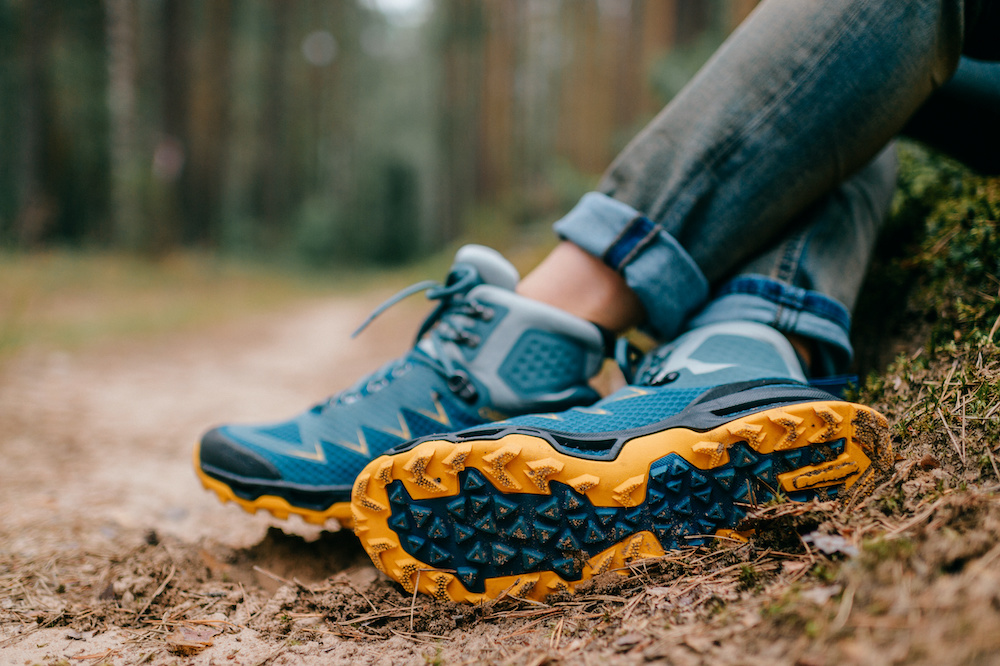
3. Fit
Getting a pair of hiking boots with the right fit is, undoubtedly, one of the major concerns for every hiker when they are on the hunt for one. The first and most important thing you must keep in mind is that the shoe should not be too tight.
Wearing tight hiking boots will end up causing calluses and blisters. Also, it could lead to you having an athlete’s foot, which is highly difficult to deal with when you hike or go camping.
Here are some tips to keep in mind to make sure that your hiking boots fit you right:
- It is imperative that you try on your hiking boots before you buy them. Trying these shoes will help you understand their fit better and also help you get a feel for them. You will get to know if they work well for your particular feet.
- Look out for hiking boots that complement the shape of your feet. For example, buying a pair of hiking shoes that have a narrow shape will be a huge mistake if you have wide feet.
- For those who buy their hiking boots online, always look for shoes that have a decent return policy. Try them out at home and check whether they fit your feet perfectly. If you are comfortable wearing them, only then should you keep them.
- It is quite common for several novice campers and hikers to buy hiking boots that have a tight fit. Make sure you avoid doing that. Your hiking shoes should have adequate space for your toes.
- Your toes should be able to move and breathe with ease. Having this space at the tip of the shoe will minimize any chances of your toes having any injury in case you make a sudden wrong movement.
4. Size
The size of the hiking shoe is essentially the same thing as the fit of the hiking shoe. Not everyone has the same size and shape of feet, which means that there will often be times where you find trouble finding the right size of the boot for yourself. In such a case, we recommend trying out the following tips.
- If you are a woman, try out men’s shoes, and if you are a man, try out a woman’s shoes. Not every shoe company has made their shoes on gender-specific lists, but if they have, those little differences may just be all the tweaking that you need to get a perfect fit.
- If you are someone who particularly has wider or narrower feet than most people, you must look for hiking boots that have a narrower or wider width. Certain brands also accommodate this feature in their shoes.
- If you are someone with particularly smaller feet, then you could search for hiking shoes in the children’s section. On the upside, you will spend lesser money. However, on the downside, children’s hiking boots may not necessarily be built to endure the abuse as the boots built for adults.
- You can also consider changing your socks. Padded, seamless socks, which are available in several sporting goods stores, will reduce the discomfort and rubbing around your ankles and toes.
Following these tips can help you find the right size of hiking boots for yourself.
5. Styles
Ensure that you are selecting the style of hiking boots based on the terrain you will be hiking on and the loads you are expected to carry. With that said, since there is added weight, your feet will take its toll with regards to the energy spent by the day’s end; hence, you must go for lightweight boots as much you can.
For example, settling on a pair of off-trail boots will be a clear overkill for a backpacker making a weekend trip with a light load and sticking only to trails. Here are some different styles of hiking boots you can consider buying.
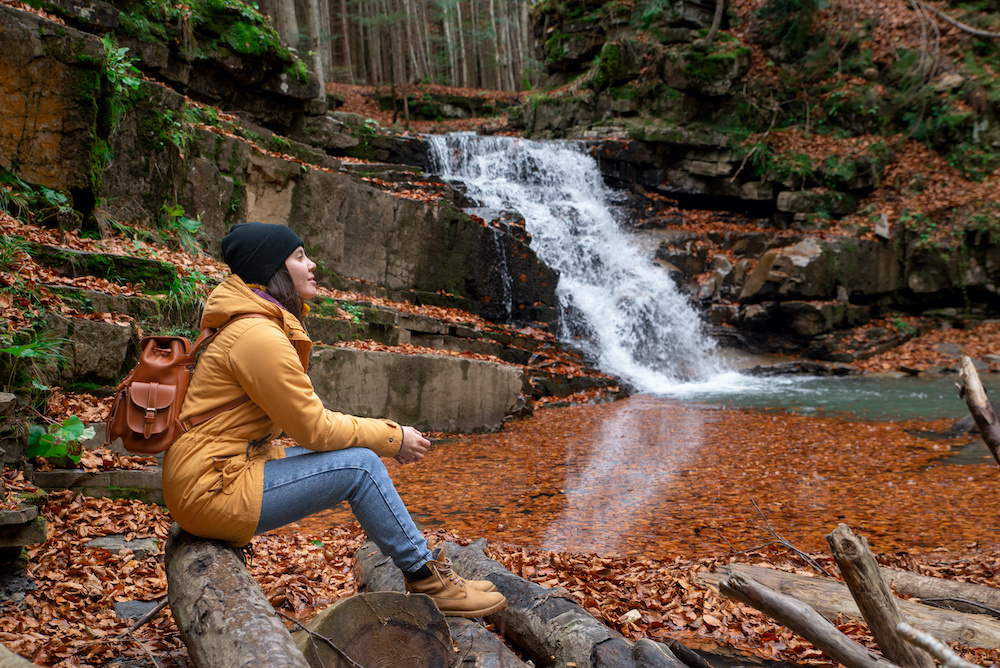
Trail
When your trail is well kept and you are packing light, mid-cut or low-cut boots are the ideal choices.
Its combination of leather/fabric or split-leather construction will typically have multiple seams, so you will have to augment them with an application of waterproofing or Gore-Tex socks, unless it comes with a breathable or waterproof liner hiding on the inside.
Trail shoes also tend to have a stiffer sole, more stability, and even better traction than your typical walking or running shoes. That said, many people still find these shoes to be a bit too unstable on slippery or rocky terrain or under a big load. You could consider making use of low-cut ankle gaiters to keep out trail detritus.
Rough-Trail
If you are doing some aggressive day hiking, then these ankle-high hiking boots are the best choice. They will be made mostly from leather/fabric combinations or split-grain leather.
Some of them have breathable and waterproof liners, while others are porous and well-ventilated for places like a hot desert.
Half-length shanks or tapered plastic midsoles give these hiking boots ample sole rigidity to protect your feet against stony trails while still allowing a good flex at the ball of your feet.
Some strong-footed hikers tend to prefer these lightweight hiking boots for extended backpacking through a serious outback. However, for many hikers, when it begins to get rough, it is time to trade up.
Off-Trail
If the only trail you walk on is a goat path through talus and alder tangles, then you will certainly appreciate the above-ankle support, full-grain leather, and rigid sole stability that these off-trail boots provide.
These boots offer the user ample protection for the feet and also provide sufficient flex at the ball of the feet for shorter stride length dictated by a weighty pack and a rough terrain.
These boots boast fantastic durability and waterproofing, thanks to its all-leather construction and minimal seams. However, that also means that it has a lengthy break-in time for the sole and heel cup to soften.
Many of these boots are also quite lightweight, thanks to the newer midsole/sole constructions. They may have a lip on the welt of the sole to accept certain types of crampons for glacier travel.
Mountaineering
These kinds of hiking boots will be typically characterized by full-grain leather uppers, excellent traction, minimal seams, and, in some cases, a bit of insulation, too. They will rise way above the ankle.
With stiff nylon midsoles or full-length shanks, these boots are typically too rigid for a comfortable full-stride hike. Yet, under a heavy pack on steep terrain, your strides will end up being short, and they will get you to the peak.
Ensure that you break-in these shoes well before you attempt much mileage, else expect to have feet with countless blisters. Look for minimal heel slippage, rockered soles, and even rubber along its welt for waterproofing and better durability.
Technical-Scrambling
These are mid-height and low-cut hybrids with a close fit, anti-abrasion toe rands, and sticky rubber soles. They are made for light hiking and scrambling and will suffice under a lightweight backpack, assuming there are good trail conditions.
If you are planning on using them for serious trail travel, then you will need gaiters to keep out twigs, sand, and gravel.
Best Hiking Boots Under 100 FAQs
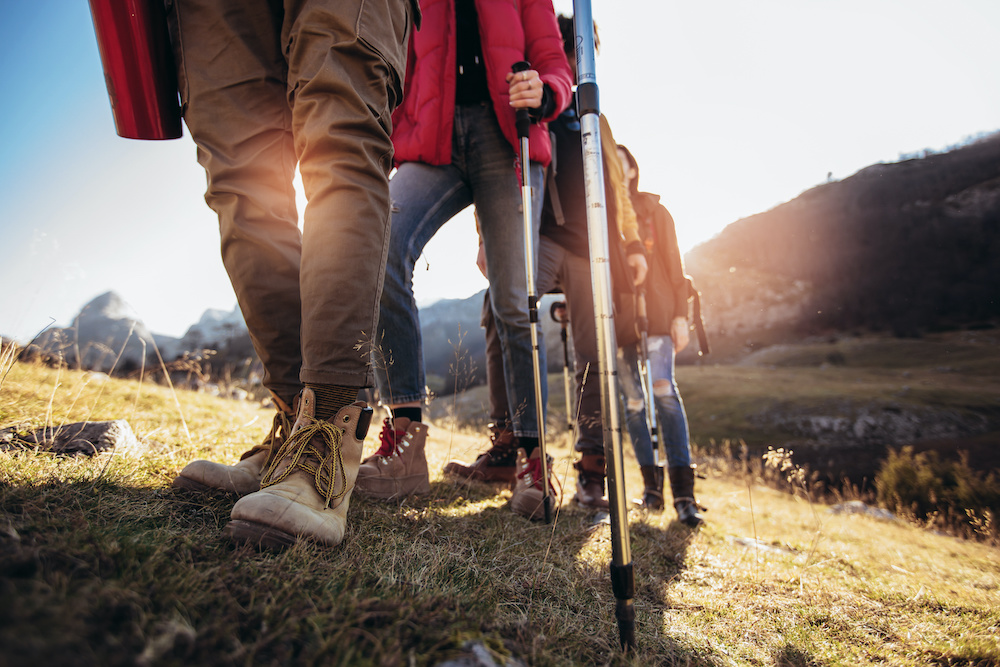
1. Are hiking boots worth it?
Even though you may use it only for certain occasions, we can say with certainty that hiking boots are worth every penny you spend on it. These are ideal to use when the trail is muddy, rocky, or wet, or all of them.
In such cases, a pair of regular shoes will get caked in the mud, leave your feet wet, and leave you with an overall terrible experience. With hiking boots, you can be assured that your feet are well protected and that they will remain dry.
A good pair of hiking boots ensure that you have a maximum level of protection. You do not feel much of the trail, but you can plow through it.
Of course, they tend to be much heavier, and you will end up using more energy by using them, but if you are hiking in extreme conditions, your main priority is to keep your feet completely dry and 100% protected. For all these reasons, you must go for hiking boots.
2. Should I get a half size bigger for hiking boots?
Certain shoemakers recommend buying hiking shoes that are half a size bigger than your usual size, but this is not always a good idea. The built and design of hiking shoes must fit the contours of your feet perfectly.
Always consider the width of your feet first before the size. Are your feet wide or narrow? Based on that, you will need to shop around until you find one that fits your feet’s shape perfectly.
Some people are flat-footed, while others have high arches. Certain boots could cause rubbing, which could lead to blistering if they are too tight or loose at any point. We would highly recommend trying out a shoe that fits your feet perfectly in every aspect rather than stressing on just the size.
3. Should you wear two pairs of socks when hiking?
Yes, wearing two pairs of socks when you hike can be advantageous. However, you need to wear the right kind of socks for that. Let us briefly talk about the characteristics of each of these socks.
- Inner Liner Sock
This sock is the tighter and thinner of the two and will sit against your skin. The main purpose of it is that it will remain more or less static against the skin, and so will prevent any friction that could lead to blisters.
- Outer Hiking Sock
This outer sock is essentially the main sock. This is thicker, and its purpose is to keep your foot warm and comfortable. That said, it will also have other functional capabilities, such as wicking away moisture.
Keep in mind that outer socks come in different thickness levels, and you will need to select it as per your hiking needs.
The main strategy of wearing two socks is to ensure that your feet can move more comfortably without the generation of any friction on your skin. Both of the socks should lead to you having a comfortable pair of feet when you hike.
4. How do you break in hiking boots fast?
If you are buying a hiking shoe from a trusted dealer, they will most likely stretch your new boots at no cost.
To quickly break in hiking boots, you can soften them by bending their soles and repeatedly manipulating them back and forth. You can also engage in deep repetitive squats to keep the soles limber.
You will often find some people suggesting wetting new hiking shoes. While this can help in breaking in the shoe quickly, it will also damage it. As such, you might want to avoid such extreme measures that could damage the shoe.
5. What does GTX mean in hiking boots?
GTX refers to Gore-Tex Lining, and this relates to the boot’s inner portion, which means that it refers to the comfort, fit, and durability of the boots, all within one feature.
This lining is made of a membrane of an extremely thin polytetrafluoroethylene (ePTFE) and is expanded to cover the surface of the boot. Its material is home to over nine billion pores in every square inch of the shoe, which says a lot about how waterproof and breathable the shoe is.
Final Verdict
We hope that our reviews of the best hiking boots under 100 have offered you a wide range of options to select from. All of these shoes are well-known among several hikers, and each of them has unique features that will meet your needs and preferences.
With these, you no longer have to worry about getting a good pair of hiking shoes by breaking the bank. We recommend that you make a choice based on our detailed buyer’s guide to ensure you are choosing the best pair for your needs.
